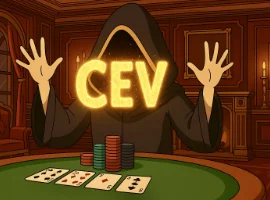After reading the last chapter, you’re probably asking yourself the following question (and if you are, you’re absolutely right):
"Okay, I get that it’s possible to win at Spin & Go, and I understand that short-term results are meaningless.
But concretely, how many games do I need to play to guarantee that I’m winning?"
To answer that, we’re going to run some simulations.
We’ll simulate the bankroll of 100 good Spin & Go regulars playing at the €1 stake (with a CEV of 65 — which is very achievable at this level).
We’ll simulate sets of 200 games, then 1,000, and finally 10,000, to observe the impact of variance.
Here’s the result:

This simulation gives us the following insights:
So, is 200 games enough to be sure you'll make money with a CEV of 65?
👉 NO.
Here’s the result of this second simulation:

This time, the insights are:
So, is 1,000 games enough to guarantee profit with a CEV of 65?
👉 NO.
Here’s the final simulation:

And the results are:
So, is 10,000 games enough to be sure you’ll make money with a CEV of 65?
👉 YES.
But note that there can still be huge gaps between theoretical and actual winnings, even among solid players.

In the short term, variance can completely distort your perception.
Even great players can go through downswings, especially over small samples (200 or 1,000 games).
Over larger volumes (10,000+ games), variance levels out — but large differences in profit can still occur among winning players.
Note: if you’d like to run your own simulations to estimate your potential earnings based on buy-in level, jackpot structure, volume, and CEV, we’ve written a guide on how to use Swongsim (good news: Swongsim is free!).













